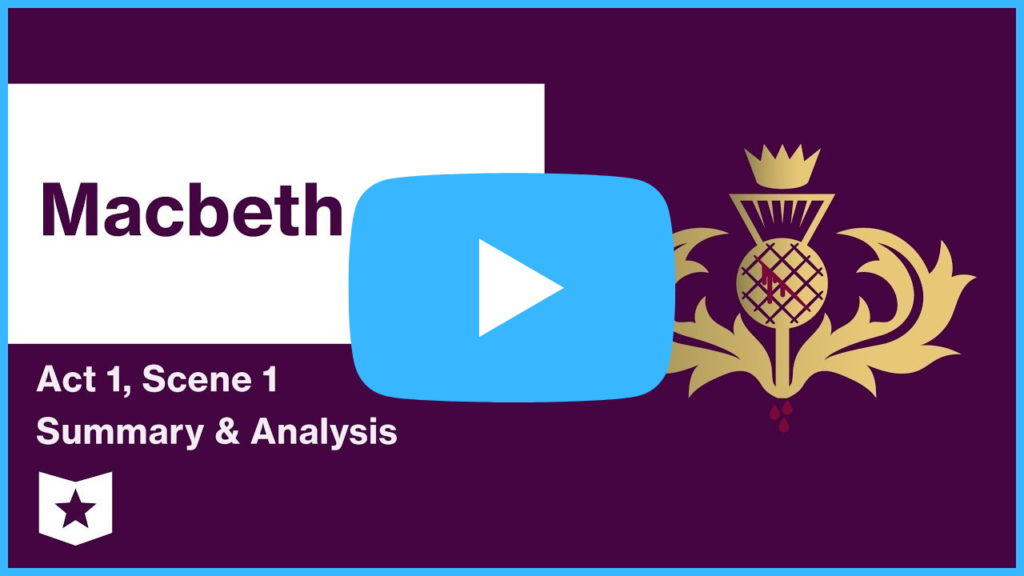This video study guide provides 36 videos that break down each act and scene for thorough summary and analysis and also contains additional videos about the context, symbols, characters, themes, and overall plot summary of William Shakespeare’s Macbeth. These videos will go a long way in helping students create their own analyses and textual citations. After watching these videos, students will better understand the themes of the text, the complex characters including their development, and the importance of word meaning and choice on the overall text and tone of the text. These videos will help students consider the author’s choices as they relate to the structure of specific parts of the text and their overall impact on the text as a whole. Students will gain insight into grasping a point of view by distinguishing what is directly stated and what is implied in the text. These videos will also lay the foundation, or build upon existing knowledge, for students to compare how two or more texts from the same period treat similar themes or topics. Course Hero also provides free resources like study guides and infographics at the link below. For a list of Common Core State Standards addressed, see below.
Download the free study guide and infographic for Macbeth by William Shakespeare here: https://www.coursehero.com/lit/Macbeth/

Common Core State Standards Macbeth by William Shakespeare
CCSS.ELA-LITERACY.RL.9-10.1
- Cite strong and thorough textual evidence to support analysis of what the text says explicitly as well as inferences drawn from the text.
CCSS.ELA-LITERACY.RL.9-10.2
- Determine a theme or central idea of a text and analyze in detail its development over the course of the text, including how it emerges and is shaped and refined by specific details; provide an objective summary of the text.
CCSS.ELA-LITERACY.RL.9-10.3
- Analyze how complex characters (e.g., those with multiple or conflicting motivations) develop over the course of a text, interact with other characters, and advance the plot or develop the theme.
CCSS.ELA-LITERACY.RL.9-10.4
- Determine the meaning of words and phrases as they are used in the text, including figurative and connotative meanings; analyze the cumulative impact of specific word choices on meaning and tone (e.g., how the language evokes a sense of time and place; how it sets a formal or informal tone).
CCSS.ELA-LITERACY.RL.9-10.5
- Analyze how an author's choices concerning how to structure a text, order events within it (e.g., parallel plots), and manipulate time (e.g., pacing, flashbacks) create such effects as mystery, tension, or surprise.
CCSS.ELA-LITERACY.RL.9-10.7
- Analyze the representation of a subject or a key scene in two different artistic mediums, including what is emphasized or absent in each treatment (e.g., Auden's "Musée des Beaux Arts" and Breughel's Landscape with the Fall of Icarus).
CCSS.ELA-LITERACY.RL.9-10.10
- By the end of grade 9, read and comprehend literature, including stories, dramas, and poems, in the grades 9-10 text complexity band proficiently, with scaffolding as needed at the high end of the range.
CCSS.ELA-LITERACY.RL.11-12.1
- Cite strong and thorough textual evidence to support analysis of what the text says explicitly as well as inferences drawn from the text, including determining where the text leaves matters uncertain.
CCSS.ELA-LITERACY.RL.11-12.2
- Determine two or more themes or central ideas of a text and analyze their development over the course of the text, including how they interact and build on one another to produce a complex account; provide an objective summary of the text.
CCSS.ELA-LITERACY.RL.11-12.3
- Analyze the impact of the author's choices regarding how to develop and relate elements of a story or drama (e.g., where a story is set, how the action is ordered, how the characters are introduced and developed).
CCSS.ELA-LITERACY.RL.11-12.4
- Determine the meaning of words and phrases as they are used in the text, including figurative and connotative meanings; analyze the impact of specific word choices on meaning and tone, including words with multiple meanings or language that is particularly fresh, engaging, or beautiful. (Include Shakespeare as well as other authors.)
CCSS.ELA-LITERACY.RL.11-12.5
- Analyze how an author's choices concerning how to structure specific parts of a text (e.g., the choice of where to begin or end a story, the choice to provide a comedic or tragic resolution) contribute to its overall structure and meaning as well as its aesthetic impact.
CCSS.ELA-LITERACY.RL.11-12.6
- Analyze a case in which grasping a point of view requires distinguishing what is directly stated in a text from what is really meant (e.g., satire, sarcasm, irony, or understatement).
CCSS.ELA-LITERACY.RL.11-12.7
- Analyze multiple interpretations of a story, drama, or poem (e.g., recorded or live production of a play or recorded novel or poetry), evaluating how each version interprets the source text. (Include at least one play by Shakespeare and one play by an American dramatist.)
CCSS.ELA-LITERACY.RL.11-12.9
- Demonstrate knowledge of eighteenth-, nineteenth- and early-twentieth-century foundational works of American literature, including how two or more texts from the same period treat similar themes or topics.


